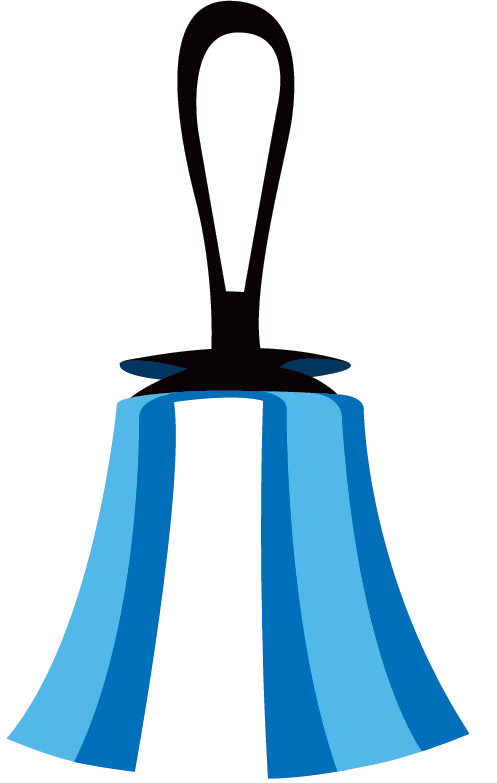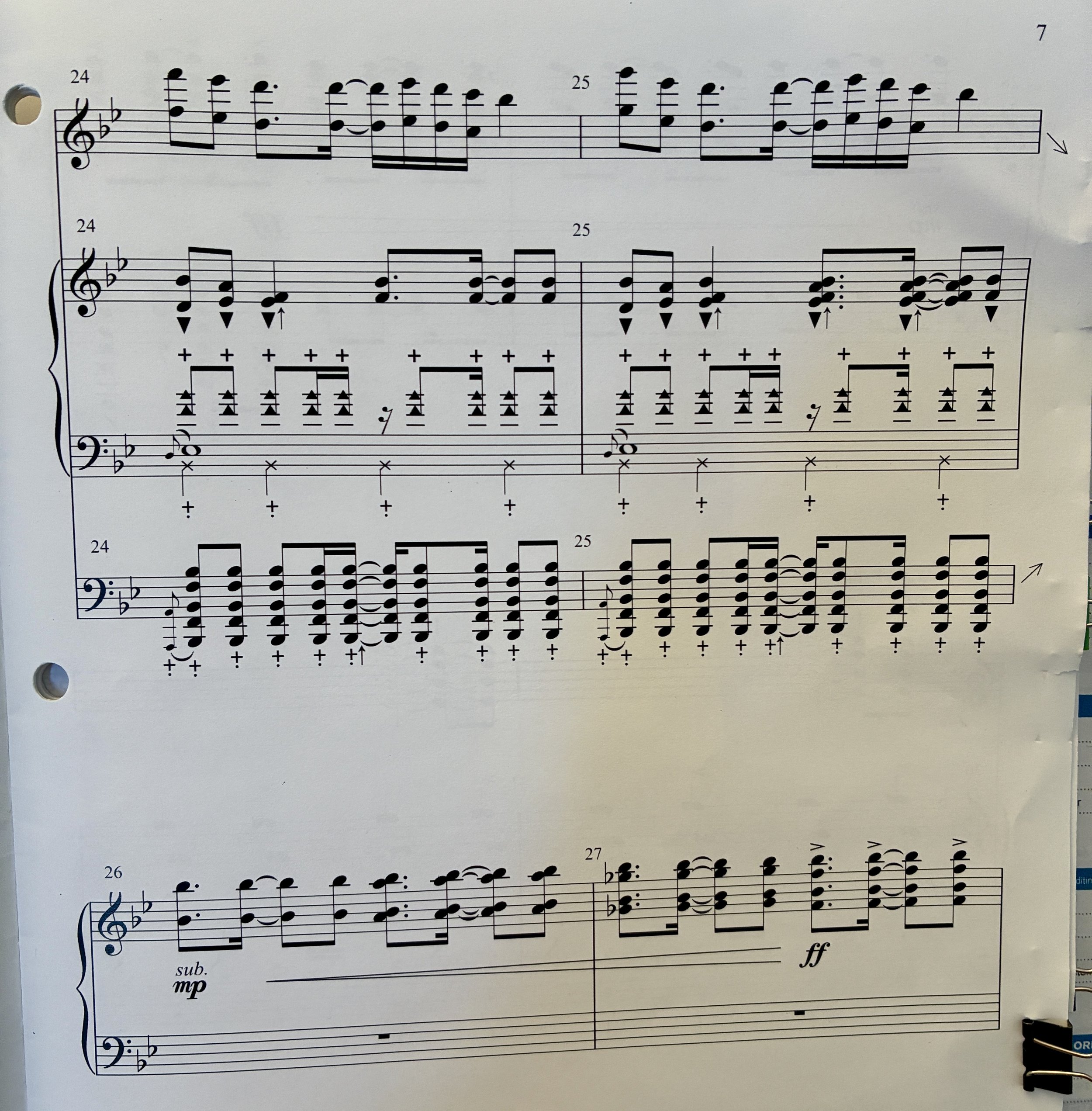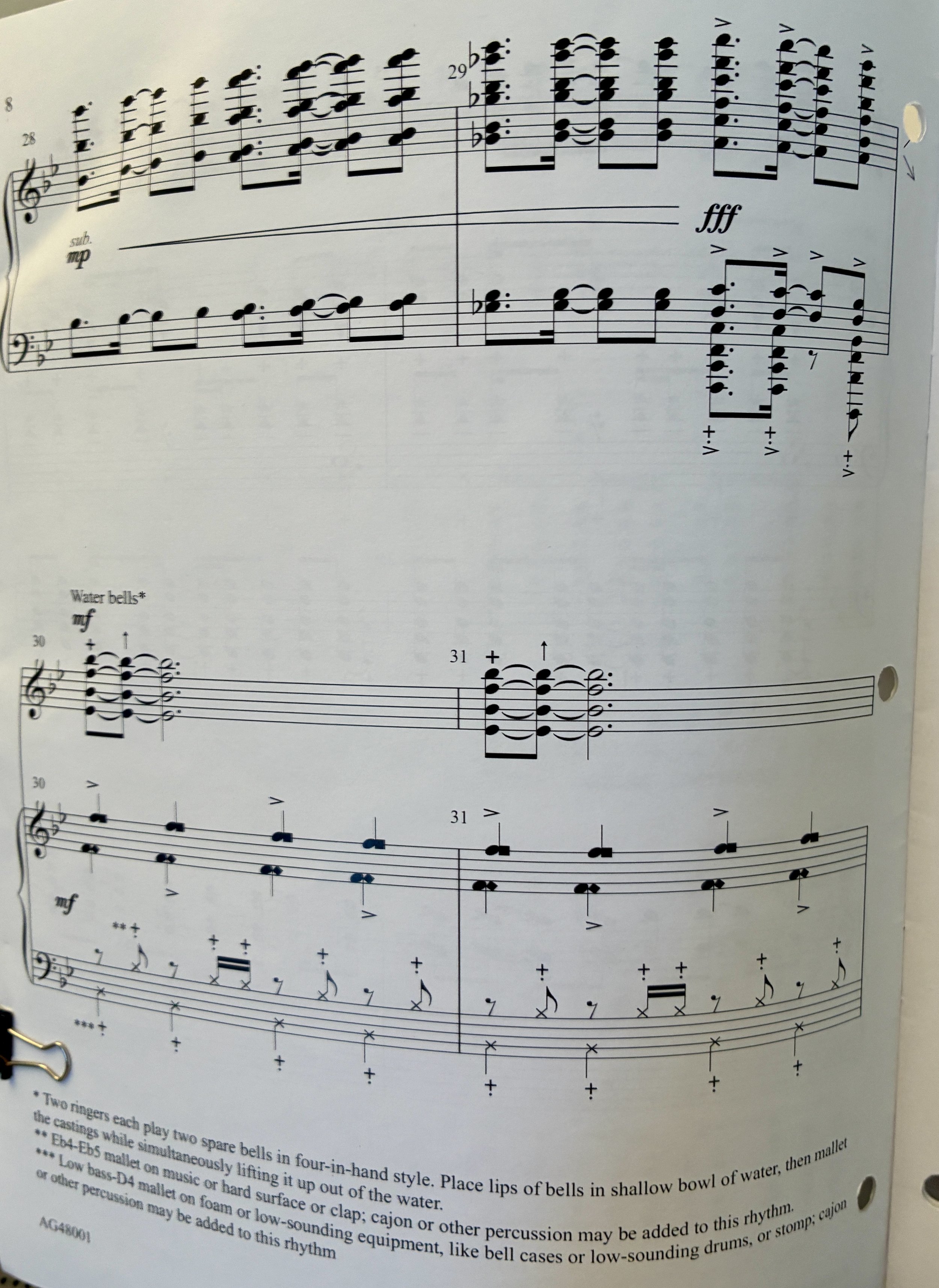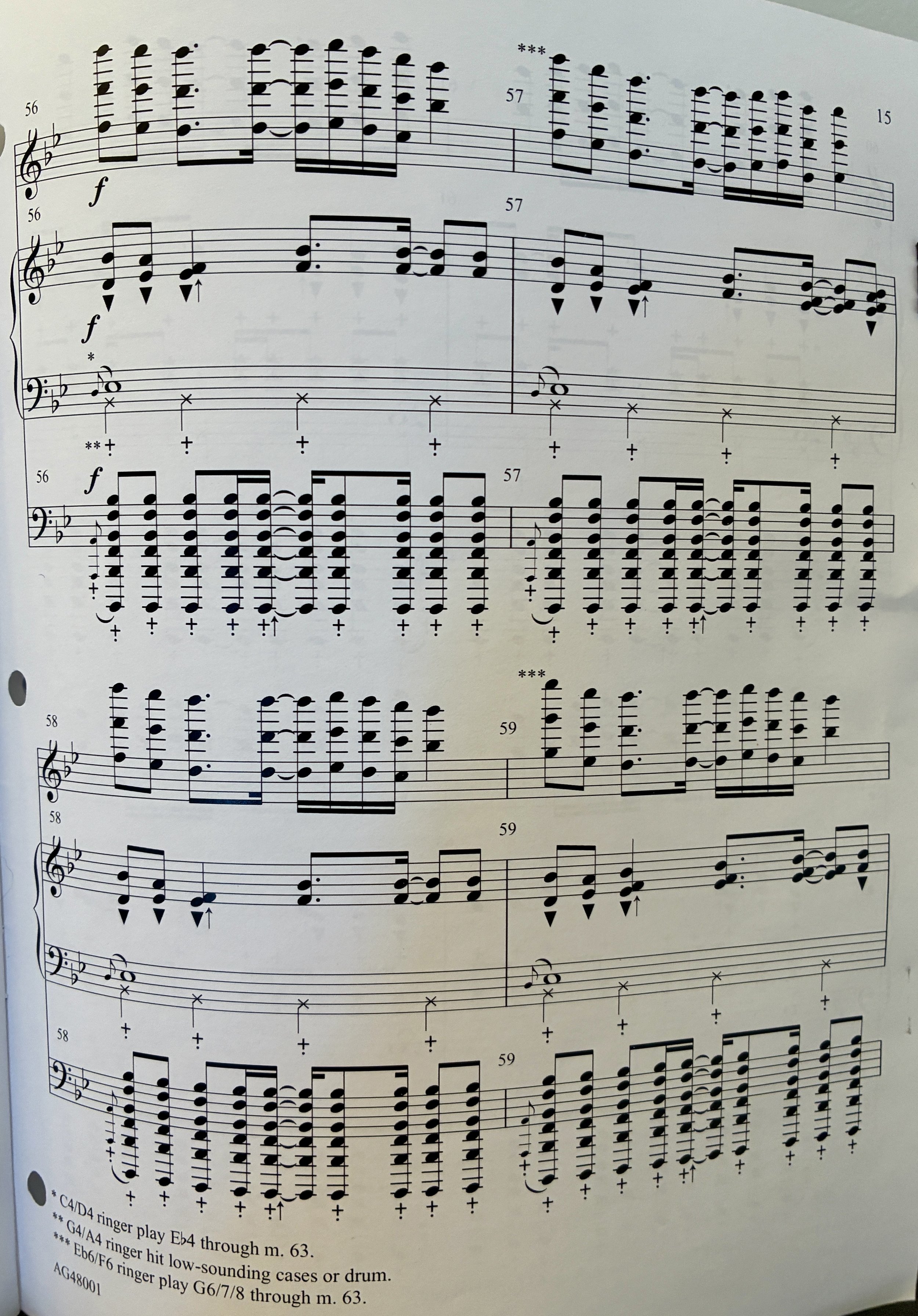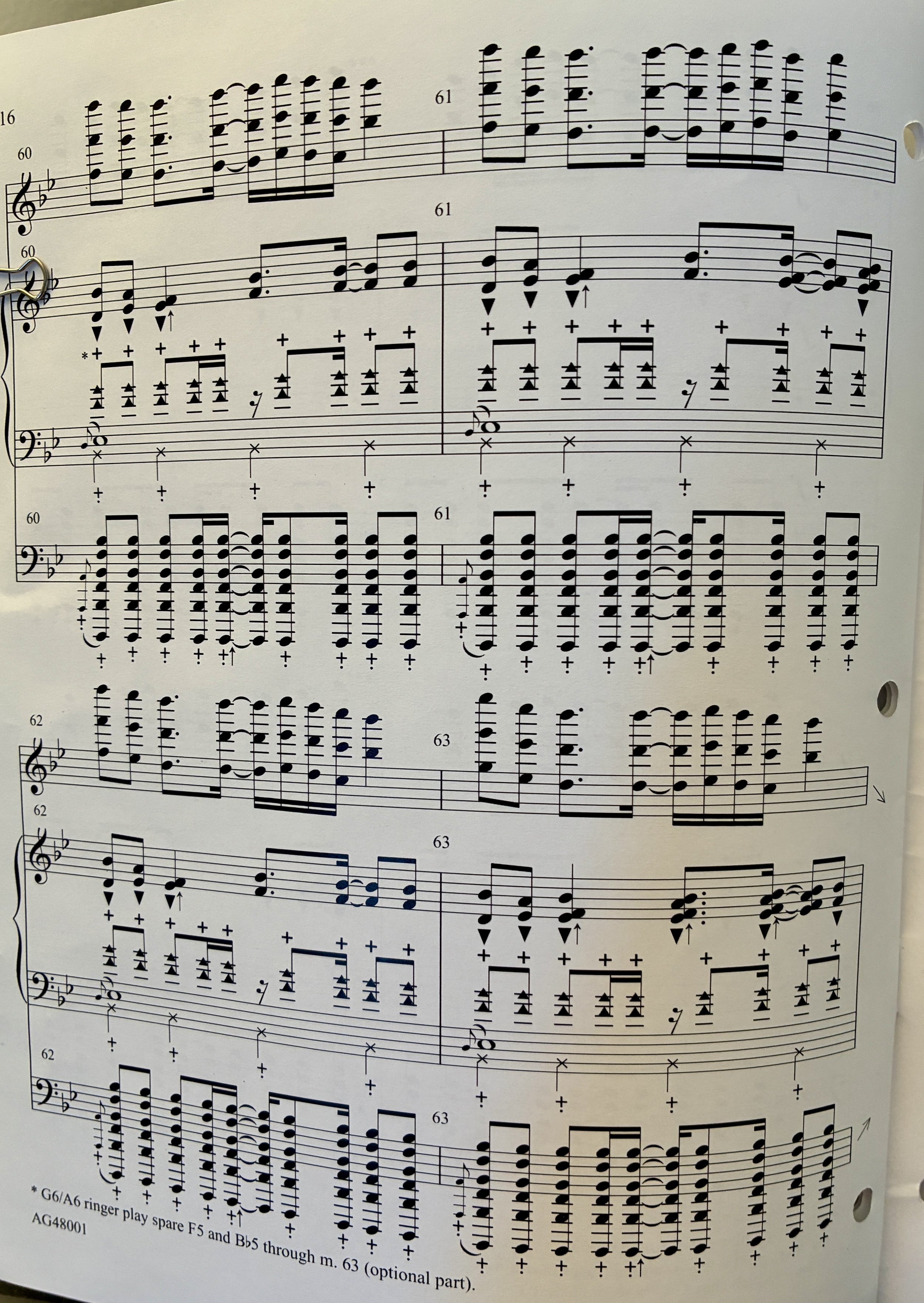
Woooooooo, at first glance through the score, this looks hard. Staff splits, note shapes not seen before, a bunch of footnotes that may or may not pertain to you, and the rhythms, amirite? It’s a lot to take in.
But once you get it broken down into its parts, it’s really not as bad as it looks. In fact, it’s relatively easy once you’ve nailed the rhythms and marked which staff you’re playing at each point in the song. So grab a nice beverage, a pencil, and a highlighter and let’s have a look at this.
Right off the bat, the Bells Used Chart is different. The top part is the main part, so have a look at that and see what bells you need. The note in the middle about the extra bells needed isn’t something you need to worry about, as those extra bells will be on a separate table off to one side at the front. Likewise, don’t (yet) worry about the other charts, as you may or may not being playing any of those notes… even if you normally play those notes. As we go through the piece, if you see that you are going to be playing any of those extra things, then you can back up and circle what you need on the other bells used charts.
But let’s look at them: There are “auxiliary handbells” - four of them: F5, Bb5, F6, Bb6
These are probably not going to be handbells at all, but something else entirely. Still working on what it will be - maybe a xylophone or tuned glasses of water or something else. Stay tuned on that.
There’s a single F5 hand chime listed. If you normally play F5 then you’ll also play this chime.
The “Optional Silver Melody Bells” are those bells that look like soup cans on a stick. We don’t have a set of those, and the one place we know of that has a set has let us know that they’re unavailable for our concert. So those will be chimes. When we get to the part of the song that incorporates these, if they’re your notes, mark them as chimes.
F3: the composer has noted that the F3 is only to be played in measures 29, 64, and 65. We’re only playing it in m29. You can cross out every other F3 in the whole song.
(Ignore the edge of the Post-it note in the upper left. My score is full of those)
First page (page 2): Nice and strong with the mart-lifts. F5 and F6, cross out the tie at the end of measure 2. You should re-ring the notes in measure 3 for the shake.
Trebles: the shake is fp so ring it nice and strong, then drop below the table and continue to ring as you bring the bell back up to shoulder height.
Page 3 - here we go with the rhythms. The tricky part of the song isn’t playing the rhythms. Once you’ve got them, you’ve got them. The tricky part is remembering which rhythm it is, and looking at the notes on the page might not trigger the muscle memory fast enough.
Solution: we’ll assign phrases to each rhythm that naturally evoke the rhythm at hand when you say them. Then you only need write the phrase on your music when the rhythm happens to instantly remind you how it goes. That first rhythm right at the top of the page will be:
Watch out world, ya know that we got this.
Look at the rhythm and say the words along with it. Makes sense, yes? When this rhythm happens anywhere else in the music, just jot the phrase down and you’ll remember how it goes without having to decipher the counting.
D4 and D5: play those grace notes beginning in m4 right on the beat as a ring-touch. For D4, you can use your free hand to immediately damp the note. The D5/Eb5 ringer play both notes simultaneously and immediately damp the D5 while leaving the Eb5 ringing. Yes, it’s awkward. You got this.
A3: play the grace notes beginning in m8 with a mallet. ( bell on the table )
Those little arrows after m7 in the treble clef indicate that you’re going to be split into multiple staffs. (Yes, I know it’s actually staves but I said what I said.) In this case, all the players who play C6 and higher will move to the top staff. Here’s where it’s a good idea to take a highlighter and colour the beginning of the staff that you’re reading. Just to give your eyes a quick “here we are” when there are lots of different staffs on the page.
D5 thru Bb5 will play the 2nd treble staff. (“Watch out world, ya know that we got this”)
C6 and higher on the upper staff. That rhythm will get this phrase attached to it:
“Here we go, ringin’ all the bells!”
In m11, there’s a note for the bass bells to damp on the table on beat 4. This is nothing fancy, just letting you know to put the bell on the table instead of shoulder damping. Why? Because you have to pick up mallets very quickly for the next measure and the composer has written into the music the best way to do it: with a table damp and a half-beat rest. What a nice guy.
Trebles C6 and higher return back to the normal treble staff after m11.
Bass bells are now malleting “Watch out, world, ya know that we got this” but with a mallet-lift on “know”.
Pay attention to the crescendo/decrescendo. It’s a nice swell effect, so let’s exaggerate it.
F3 remember that you don’t play here. Only in m29.
D4 and A4, from measures 14-17, mallet quarter notes on the table, also following the crescendo/decrescendo markings.
Treble bells on the shakes beginning in m14: notice the crescendo/decrescendo. What we’ll do here is start the shake near the table, then take four counts to bring it up to shoulder height as you shake. At m15, take four beats to go from shoulder height to near the table.
Treble bells begin the shake in m16 near the table and take four counts to get to shoulder level (as before).
E6, G6, Bb6 in m17, begin the shake at shoulder level and do a full ringing circular motion over the four beats.
E5, G5, Bb5 in m17, play the half note shake as a quarter note shake, then let it ring thru beat 2. E5, I suggest you put your bell on the table a little early so you can get to your bells in the next measure on time.
D4, pick up the Eb4 sometime before m18.
After m17, both treble and bass split into two staffs each. Beginning in m18,
C6 and higher are on the top staff, ringing “Here we go, ringin’ all the bells!”
G6/A6 ringer: turn your music to page 18, then move into position to play whatever it is that you’ll be playing on the next page. To be determined later.
D5 thru Bb5 are on the second staff. That rhythm is easy enough, it doesn’t need a phrase.
C4/D4 ringer. Play the Eb4 you’ve already got in your hand and mallet the D4 grace note right on the beat.
G4/A4 ringer mallet a large bell case on those quarter notes that are written as Bb3. You might make a note on the first page that you need a bell case for this song. Suggestion: stand the case up on its end and set it slightly behind you. When you get to this measure, sit down on the case and mallet it from there like a cajon.
The rest of the bass bells are on the bottom staff malleting “Watch out world, ya know that we got this” with the mallet-lift on “know”.
F3 does not play here.
A3 play the grace note slightly ahead of the beat rather than on the beat like the other grace notes. If you’re familiar with drums, play it like a flam.
Everyone continues as before, but in m21, the “Here” word in “Here we go, ringin’ all the bells!” is a G6/7 instead of an F6/7 for some reason. It’s not a typo, since the composer has made a note that the notes should be played by the F6/7 ringer, since the G6/A6 ringer has gone walkabout to play whatever it is they’ll be playing.
In m22-25, the G6/A6 ringer will be in position to play “Watch out world, ya know that we got this” on whatever thing we’ll get for this bit. Might be piano, might be xylophone, maybe tuned water glasses. Dunno yet. But it’s you playing it, no matter what it ends up being. It’s notated with pyramid-shaped notes on the third staff, by the way, but your music will be back on your table, so I’ll cue you to play “Watch out world, ya know that we got this” on F and Bb four times through.
First two measures, m24-25, more of the same. F6/7 ringer notice that it changes to a G6/7 again in m25.
Eddie and Brayden make your way to the table with the water bells.
In m26:
G6/A6 ringer, stay put and wait for your next cue.
E6/F6 ringer play that Gb6 as the regular ringer probably won’t be back to the table yet. Continue playing it in m29 on the next page.
Notice that it’s suddenly soft but has a quick crescendo to a ff on beat 3 of m27.
All other ringers: quietly turn your page now. Trust me.
Beginning in m30:
Eddie and Brayden are on the top staff playing water bells
F5 and F6 are on the second staff with a bell in one hand and a chime (square notes) in the other. Pay attention to the accent marks.
Trebles clap the rhythm on the bass staff, stems up.
Basses stomp the quarter notes on the bass staff, stems down.
G6/A6 you can either mallet click quarter notes, or dance in place (or both!) Your choice.
Beginning in m34
D5 thru Bb5 play the middle staff on chimes.
Everyone else continue as before.
Top staff: Eddie and Brayden playing water bells
Middle staff: D5 thru F6 play square notes on chimes
Bass staff: Everyone else continue stomping and clapping as before
Beginning in m38, lower basses drop to the bottom staff and mallet your part there.
Beats one and two of this pattern, do not mallet-lift, just mallet on the table as usual. Continue with that through m49
Everyone continue as before
G6/A6, I will cue you at m42 to resume playing “Watch out world, ya know that we got this”
Don’t worry about the addition of the quarter note pyramids at m46. We aren’t playing those.
Everyone continue as before.
Everyone continue as before. Notice the repeat ad lib at the end of m49. That doesn’t mean you can start ad libbing your part - it means that we repeat that 4-measure pattern that we’ve been doing as many times as the director indicates, but there’s no set number of times, so you have to watch the director for the cue to continue to m50. Not sure how many times this will be, it might change every time. Maybe other things will get added in. Maybe we’ll have the audience start a conga line. Who knows?
At m50:
Eddie and Brayden carefully dry off the bells and return to your regular positions.
Trebles play the second staff, on a new rhythm: “Ringing bells, we love what we do. Hey!” The mart comes on “hey!”
G6/A6 mallet click quarter notes on the beat.
A3/Bb3 and F4 play the lower staff. A3 play the grace note just before the beat, like a flam.
The rest of the basses plus trebles not yet playing, do the stomp/clap rhythms as indicated in the top or 3rd staff.
Trebles change m53 to the same rhythm as m52 ( “Ringing bells, we love what we do. Hey!” )
At m54, Bb5 and higher play “Watch out world, ya know that we got this”
D4 and D5: play those grace notes beginning in m4 right on the beat as a ring-touch. For D4, you can use your free hand to immediately damp the note. The D5/Eb5 ringer play both notes simultaneously and immediately damp the D5 while leaving the Eb5 ringing. Yes, it’s awkward, but you know how to do this from a few pages ago.
None of the parts are new, it’s just assembled differently.
Top staff: C6 and higher playing “Here we go, ringin’ all the bells” Notice the
Second staff: D5 thru Bb5
Third staff: C4/D4 ringer playing D4/Eb4 as you did before. G4/A4 continue as before
G6/A6, you may mallet click on the beat or dance in place (or both!)
Top staff: C6 and higher playing “Here we go, ringin’ all the bells!”
G6/A6 plays “Watch out world, ya know that we got this” four times (I will cue you), then return back to your regular spot at the tables. You’ve got lots of time, no rush.
Second staff: D5-Bb5 doin’ yer thang.
Third staff: C4/D4 and G4/A4 keep on keepin’ on.
Bottom staff: basses playing “Watch out world, ya know that we got this” with the grace notes slightly ahead of the beat like a flam.
This is different than what’s on your music, make notes carefully here:
Measures 64-65
G5 and higher (the triplets): play the passage as written, but do not shake any of the notes.
Bb4/C5, Eb5, F5: Shake for six beats only, then let it continue ringing through the last two beats of m65
Basses: cross out the LV and ring normally. Only play the top notes of the 8th note runs. If you have no notes to play, get your mallets ready.
Measure 66:
Bb4/C5 and all trebles: play beat one as a Ring-Touch (RT) and cross out the dotted half note shake. Only play the RT on beat one.
Basses mallet roll beginning at mp and quickly crescendo to ff in four beats.
Measures 67-68
Top staff: any trebles without notes to play in the second staff.
Second staff: trebles playing “Ringing bells, we love what we do. Hey!”
Third staff: any basses without notes to play in the bottom staff
Bottom staff: basses play as written
Everyone change the rhythm you’re playing in m70 to the full “Ringing bells, we love what we do. Hey!” (the same rhythm the trebles play in m69)
In m71, the rhythm changes back to “Watch out world, ya know that we got this.”
C4/D4, G4/A4, and C6/D6 pick up a pair of mallets and begin mallet-clicks on quarter notes at m72.
Measure 74:
Bb4 and all trebles be aware that you stop at the word “know” in “Watch out, world, ya know that we got this”
C4/D4, G4/A4, and C6/D6 continue quarter note mallet clicks to the end of the song.
Basses: play the indicated notes, but play the full rhythm “Watch out, world, ya know that we got this” and repeat it again in m75
Measure 75:
Basses, play the full rhythm “Watch out, world, ya know that we got this” observing the p < f crescendo
Trebles, begin a new shake below the table and raise it to shoulder height by beat 4.
Measure 76:
C4/D4, G4/A4, and C6/D6 play your final mallet click over your head
Trebles with a note to play: RT - if possible, use a free hand to grab the bell to damp it. If not, RT as normal
E5 and A6: grab your shaking bell and damp it right on beat one of m76
Basses: play as written
